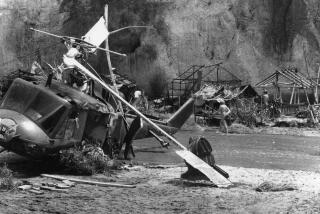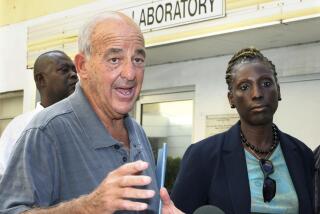For Coroner, Studying Death Is Not Just a Living
- Share via
Warren Lovell has played many roles in life.
He bombed Japan in World War II, investigated airplane crashes for the government, helped design the Mercury space capsule, launched the pathology division of a Seattle hospital and raised five children to adulthood.
Now he is 68, and his latest job, as Ventura County coroner, is taking clues from the dead to benefit the living.
Since Lovell was appointed in 1981, his autopsies have helped win numerous murder convictions and a reputation with prosecutors as a thorough, knowledgeable witness whom juries seem to like.
His office, which conducts more than 500 autopsies a year, has also won praise from his boss, County Health Care Agency Director Philip Wessels. “I think Dr. Lovell runs a very efficient operation,” Wessels said.
However, Dist. Atty. Michael D. Bradbury criticized Lovell’s performance on some high-profile murders.
“We have had some concerns with Lovell,” Bradbury said, refusing to cite specific cases. “He’s vacillated on the cause of death in some cases, and we’ve had to ask him to take his time and come up with a definitive report.”
Lovell did cite two possible causes of death in the March 23 slaying of Paul Bailly, 8, of Northridge, whose gagged, burned body was found March 23 in a brush fire near Simi Valley. Lovell ruled that Paul either choked on his own vomit or was strangled.
Bradbury also said of Lovell, “He sometimes gives information to the media before he gives it to the law enforcement people involved, and sometimes that can impede the investigation. But we’ve talked about it, and I don’t think we’ll see that again.”
However, Bradbury praised Lovell for being a good teacher, who talks investigators through his autopsies rather than merely announcing the cause of death.
Lovell is “less strange than most pathologists. Anybody that makes a living cutting up dead bodies is not your ordinary, everyday person,” Bradbury said. “I like Warren very much, and I think he tries very hard to do a good job and to do what’s right, and the concerns we have I don’t think are extraordinary.”
Lovell shrugged off Bradbury’s charge that he is sometimes indecisive, saying prosecutors always want what they sometimes can’t have--a definitive diagnosis.
“Life and death and the cause of death is not always that clear,” Lovell said. “I like to be honest about that.”
And as for his alleged coziness with the press during homicide investigations, Lovell pointed to the Bailly autopsy.
“We absolutely did not say anything for five days, whereas he was giving big public statements immediately afterward,” Lovell said of Bradbury. Blue eyes twinkling mischievously, Lovell added, “but of course, he’s facing an election.”
Lovell seems not to care much what others think.
When he ruled two weeks ago that a Taser stun gun had been the primary cause of the Feb. 13 death of a 24-year-old psychiatric patient, Lovell also urged the Ventura police to restrict their use of the weapon.
Ventura Police Capt. Randy G. Adams said “the coroner exceeded the scope of his report” by commenting on the Taser policy.
But Lovell has his fans, too.
Sheriff’s Lt. Gary Backman and Municipal Court Commissioner John Paventi remember a case that Lovell helped them solve in 1986 when they were homicide Detective Backman and Deputy Dist. Atty. Paventi.
A body had been found near Lake Piru, minus head and hands.
Lacking anything to compare to dental charts or fingerprints, Lovell took note of the dead man’s surgical scars, the hand-sewn clothes he wore and his advanced case of psoriasis.
Lovell helped prosecutors narrow the possibilities to one missing man, Edmund Krulakowski. Using Lovell’s tentative identification, prosecutors concluded that an unemployed meat cutter named Ronald Galeska had killed Krulakowski and used false identification to move into his house in North Hollywood, Paventi said.
Galeska was convicted of murder and sentenced to life in prison without possibility of parole, Backman said.
“He’s very thorough on his autopsies,” Backman said.
Lovell’s office is as densely packed as his resume.
The walls are papered with medical degrees and licenses. The shelves hold family snapshots, medical texts, two old mess kits, a model of the lower spine, a shotgun for bird hunting and a chunk of human tissue embedded in resin.
His old Air Force flight suit hangs on the back of the door and his Air Force dress uniform cap perches on a stack of medical journals. The seed of Lovell’s medical career was planted in the cockpit of the B-25 he flew in the South Pacific during World War II and was nurtured with his medical studies in the Pacific Northwest in the 1940s and 1950s.
It grew into his work as chief of aerospace pathology at the Armed Forces Institute of Pathology in Washington. Lovell headed a team that investigated military airplane crashes.
In January, 1960, it did its first investigation for the Civil Aeronautics Board. An airliner crashed in North Carolina, killing 34 people. Investigators found a body 16 miles from the wreckage with clock parts, metal flakes and manganese dioxide embedded in it. They suspected a bomb.
Unfortunately, then-FBI Director J. Edgar Hoover already had reported no foul play was involved, and did not acknowledge the bomb theory until three weeks later.
FBI agents learned that the man had carried the bomb on board after taking buying a $1-million insurance policy to benefit his wife, Lovell said.
He also remembers the case that made him quit investigating airplane accidents: a crash in Alaska that killed 44 of 200 U.S. soldiers aboard.
“It was tragic,” Lovell said. “Well, they’re all tragic, but that one really bothered me. They were young kids, the age of my kids, and I just decided that was it. I only went on one other.”
Meanwhile, Lovell had met and married his first wife, Mary, and they began what would be a family of five children.
After a two-year residency in Seattle, Lovell was asked in 1960 to start the pathology unit of the new Northwest Hospital.
He and another pathologist began a practice on the side in 1966. It grew into a five-doctor partnership.
He served as a deputy medical examiner for King County, Wash., from 1961 to 1973, consultant to the Federal Aviation Administration’s air surgeon from 1961 to 1975, a pathology professor at the University of Washington School of Medicine from 1961 to 1981 and consultant to the Civil Aviation Administration of Taiwan from 1967 to 1975.
Then in 1978 he separated from his wife, with whom he remains friendly after a divorce in 1980, Lovell said.
In 1979 “I had a blowup with my partners” and left Seattle, he said. He met his second wife, June, on an airplane. A stewardess asked what she could get him. “Oh, can you get me a new wife?” Lovell recalled saying. “I said, ‘She has to be over 40, not afraid of airplanes, Christian but sexy,’ and she said, ‘Oh, that’s my boss.’ ”
The stewardess introduced Lovell to the woman he married in 1981.
That was also the year that Lovell answered an ad in the Journal of the American Medical Assn.
After a round of interviews, he was hired as Ventura County coroner by the County Health Care Agency director.
Lovell’s staff conducts up to 500 autopsies a year.
“We’ve got top-flight police in Ventura County,” he said. “Our working relationship is very good, and we know all the crime detectives by their first name. Generally speaking, our role isn’t as dramatic as ‘Quincy.’ We try to determine who it is who was killed, how he was killed and when he was killed.”
Lovell said he hopes to work as coroner until he’s 70, then to volunteer his medical training to migrant workers and testify as an expert in civil trials, which he now does for $250 an hour “as a hobby.” He doesn’t like the idea of retiring.
“Pathology’s a fascinating field,” he said. “It’s a mix of science and medicine, and you’re expected to know something about everything. You don’t just work with dead bodies. You deal with life and death all together. A very small percentage of time is spent down in the morgue.”
During a recent autopsy, Lovell worked with swift, deft strokes of the scalpel, removing each organ and examining it for signs of illness. Forty minutes after the first incision, he recited his conclusion into his hanging microphone: The woman had died from a bleeding ulcer.
“Autopsies are fatiguing,” he said with a sigh as he stripped off his scrubs. “No matter how many you do, it’s always a little bit of an emotional strain. Sometimes you wonder who the person was. . . . Sometimes you get pretty detached. But so often it seems like you’re seeing the end of a tragic event.”
More to Read
Sign up for Essential California
The most important California stories and recommendations in your inbox every morning.
You may occasionally receive promotional content from the Los Angeles Times.













